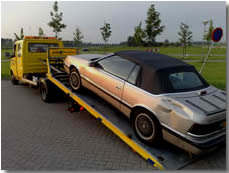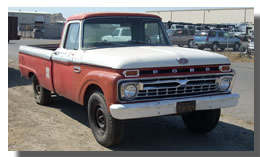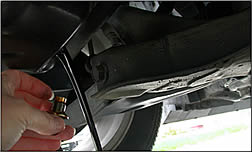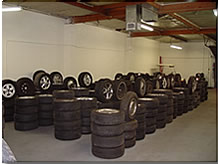
Vehicle Recycling General Permit (RVR)
The New Jersey Department of Environmental Protection (NJDEP) has issued a new Industrial Stormwater General Permit for facilities that engage in Vehicle Recycling. The ultimate goal of this permit is to have effective best management practices (BMPs), which are documented in theStormwater Pollution Prevention Plan (SPPP), as well as other permit conditions to ensure stormwater quality.
RVR is the discharge category code for the Vehicle Recycling General Permit.
This website is designed to help facilities comply with the permit and to give key points to minimize environmental hazards and exposures.
Individual authorizations issued under this master permit require the following:
- Eliminate and/or minimize exposure by implementing Best Management Practices (BMPS).
- Update and/or prepare a Stormwater Pollution Prevention Plan (SPPP).
- Conduct Annual Inspections to ensure compliance with BMPS and other permit conditions. The first Annual Inspection shall be completed on or before October 1, 2013.
- Prepare an Annual Report and maintain this report on site. The first Annual Report shall be completed on or before October 1, 2013.
- Prepare an Annual Certification by maintaining the Department’s RVR Certification Form on site. The first Annual Certification shall be completed on or before October 1, 2013.
RVR Stormwater Pollution Prevention Plan – Sample Template
Preparation of an SPPP helps permittees in identifying potential sources of pollution and in establishing best management practices to minimize and/or eliminate the exposure of these pollutant sources.
The SPPP is a document that your facility must prepare, maintain and sign. The information should include how your facility will address the following BMPs:
- Inbound Vehicle Inspection Area
- Vehicle Fluid Draining & Dismantling Area
- Vehicle Parts Storage Area
- Parts Cleaning/Solvent Degreasing
- Fluid Storage Area
- Processed Vehicle Storage Area
- Operable Vehicle Storage Area
- Facility Hydraulic Equipment
- Spill Prevention and Response
- Site Stabilization and Dust Control
The SPPP shall also include the following:
- Process Line Diagram
- Site Map
- Inventory of Source Materials
- Identification of an SPPP Team
- Inspections
- Annual Report
- Annual Certification
Your SPPP must document your facility’s methods of cleaning this visible sheen. An example of a cleaning method includes an absorbant such as kitty litter.
Best Management Practices
How to Get Your Facility Up and Running Quickly!
We are committed to making compliance with the general stormwater as simple as possible. This quick guide will help you understand the core requirements of the permit. Please feel free to contact your permit writer or Compliance and Enforcement officer for more assistance. Please refer to your facility’s stormwater permit for more detailed information.
After you complete and submit your permit application, you will be issued an authorization to discharge under this master general permit so long as your facility meets the eligibility criteria. Upon receiving the permit, you must evaluate your site for environmental sources of concern. This can be accomplished simply by walking through your facility and identifying area(s) where source materials (e.g., engine blocks, vehicle fluids, etc.) are exposed to the elements. Start thinking about how you can minimize or eliminate these source materials from exposure to stormwater.
The next step is to establish how your facility operates when a vehicle arrives. The first area the facility needs to establish is the “Vehicle Inspection Area”. Best management practices (BMPs) must be implemented at this area to assure environmental impacts are kept to a minimum. The Vehicle Inspection Area is where a leaking vehicle can be dealt with quickly with available absorbent materials. More detailed BMP information can be found on the Inbound Vehicle Inspection Area page.
After inspection, the vehicle must be drained of all fluids and dismantled. This must be performed in your facility’s “Fluid Draining and Dismantling Area”. This area has the option of being indoors or under cover on an impervious surface, such as a concrete pad. This area is designed to eliminate these source materials from exposure to stormwater. More detailed BMP information can be found on the Fluid Draining and Dismantling Area page.
After processing and draining the vehicle, you must store the fluids in your “Vehicle Fluid Storage Area”. All drained fluids must be placed in secondary containment and labeled for easy identification of contents. More detailed BMP information can be found on the Vehicle Fluid Storage Area page.
Facilities that dismantle the vehicle and sell the parts must construct a “Vehicle Parts Storage Area”. This is an area in which all engine blocks, cores, transmissions/drive components and other oily materials must be stored either indoors or in leak-proof containers on an impervious surface under cover. For example, parts can be stored on a shelf with a bermed concrete pad under a roof. More detailed BMP information can be found on the Vehicle Parts Storage page.
If the facility sells whole cars for resale, then you must designate an area for Operable Vehicle Storage Area. Operable vehicles are vehicles which can be started by a key and able to run continuously. These vehicles shall be stored in a designated area with their hoods down or by covering the engine compartment. Operable vehicles shall not leak or drip onto the ground or have pollutants exposed to stormwater. Parts which never contained fluids may be removed from vehicles stored in this area, such as head lights or bumpers.
The permit document contains additional BMP requirements as well as a requirement to maintain a Stormwater Pollution Prevention Plan on site. Please refer to the permit document for more specific information.
The first step your facility can accomplish in minimizing environmental hazards is to inspect all inbound vehicles.
Your facility must establish an “Inbound Vehicle Inspection Area”.
The “Inbound Vehicle Inspection Area” is where your facility first receives incoming vehicles. Any vehicles that are found to be leaking must be immediately moved to an impervious surface, such as a concrete pad that is contained. This area must be kept clean and be equipped with spill kits.
Inspect incoming vehicles for leaks in engines, radiators, transmissions, differentials, fuel tanks and damaged areas. Leaks must be identified and stopped immediately. Leaks can be controlled using spill kits, absorbent materials, drip pans or trays.
Vehicles in this area must be stored with their hoods down.
Quick Tips
- Establish an “Incoming Vehicle Inspection Area” for your facility.
- Good management of this area is the first step in minimizing environmental hazards.
- Inspect all vehicles for leaks.
- Leaking vehicles must be kept on a bermed impervious surface, such as a concrete pad.
- Identify, stop and control all leaks immediately and clean up using spill kits, absorbent materials or drip trays.
- Store vehicles with their hoods down.
 Operable Vehicles are vehicles which can be started by a key and are able to run continuously. These vehicles shall be stored in a designated area with their hoods down or by covering the engine compartment.
Operable Vehicles are vehicles which can be started by a key and are able to run continuously. These vehicles shall be stored in a designated area with their hoods down or by covering the engine compartment.
Operable Vehicles shall not leak or drip onto the ground or have pollutants exposed to stormwater.
Parts which never contained fluids may be removed from vehicles stored in this area. Examples of these types of parts include head lights or bumpers.
 Your facility must establish a “Fluid Draining and Dismantling Area” on an impervious surface that is contained and under cover. For example, a concrete pad (with a berm to prevent fluid spills from leaving the pad) that is under a roof is acceptable.
Your facility must establish a “Fluid Draining and Dismantling Area” on an impervious surface that is contained and under cover. For example, a concrete pad (with a berm to prevent fluid spills from leaving the pad) that is under a roof is acceptable.
Drain all fluids from vehicles into appropriate containers on an impervious surface that is contained and under cover. The cover must be constructed to prevent exposure to stormwater.
Fluids must be drained from: engines, radiators, transmissions, heater cores, brake lines, differentials, all lines and hoses, fuel tanks, air conditioning units and window washing fluid tanks. Fluids include, but are not limited to, fuel(s) engine oil(s), coolant(s), brake fluid(s), power steering fluid(s), transmission fluid(s) and wiper fluid(s).
Fluids do not need to be drained from sealed units that do not leak and are intended to be sold as complete units. Examples of sealed units include differentials, steering gear units, front and rear axle assemblies and transfer cases. Fluids do not need to be drained from units that are part of an operable vehicle.
All fluids must be drained from vehicles prior to leaving the designated Fluid Draining and Dismantling Area. Mercury switches and batteries must also be removed from vehicle prior to leaving the Fluid Draining and Dismaneling Area.
Quick Tips
- Establish a “Fluid Draining and Dismantling Area” for your facility.
- Area must be on an impervious surface that is contained and under cover.
- Cover must be constructed to prevent exposure to stormwater.
- Drain all fluids from vehicles into appropriate containers.
- All fluids must be drained prior to leaving the “Fluid and Dismantling Area”.
 Establish a Fluid Storage Area for your facility.
Establish a Fluid Storage Area for your facility.
The “Fluid Storage Area” shall be either indoors, or on an impervious surface that is contained and under cover. For example, a concrete pad with a berm to prevent fluid spills from leaving the pad that is located under a roof is acceptable.
All drained fluids must be placed in secondary containment and labeled for easy identification of contents.
All drained fluid shall be hauled off-site for recycling/disposal by a NJDEP licensed hauler. Receipts of recycling/disposal shall be kept onsite for a period of five years.
Quick Tips
- Establish a “Vehicle Fluid Storagae Area” on an impervious surface that is contained and under cover.
- Cover must be constructed to prevent exposure to stormwater or the ground.
- Vehicle fluids include, but are not limited to: fuels(s), engine oil(s), coolant(s), brake fluid(s), power steering fluid(s), transmission fluid(s), wiper fluid(s).
 Containing parts and storing them properly prevents exposure to stormwater and the ground.
Containing parts and storing them properly prevents exposure to stormwater and the ground.
Your facility must construct a “Vehicle Parts Storage Area” on an impervious surface that is contained and under cover. For example, a concrete pad with a berm to prevent fluid spills from leaving the pad while being under a roof or indoors.
All engine blocks, cores, transmissions/drive components and other oily materials must be stored either indoors or in leak-proof containers on an impervious surface under cover. For example, stored on a shelf with a bermed concrete pad under a roof.
<p “>All batteries must be removed from vehicles and stored either indoors or in leak-proof containers on an impervious surface under cover. For example, stored in plastic bin with a lid on a concrete floor.
All lead parts must be removed and stored under cover. This includes, battery cable end and lead tire weights. 
Quick Tips
- Facility must construct a “Vehicle Parts Storage Area” on an impervious surface that is contained and under cover.
- All major vehicle components and oily materials must be stored in the “Vehicle Parts Storage Area”.
- All batteries and lead parts must be removed and stored in the “Vehicle Parts Storage Area”.
Mercury is a highly toxic metal often found in several vehicle applications. Once released into the environment, mercury cannot be recovered.
Mercury is a liquid metal and is often used in industrial applications.
PCBs were often used in coolant and dielectric applications before being banned by US Congress in 1979.
Mercury switches are often used in under the hood and truck lighting, four-wheel drive anti-lock braking systems and high intensity discharge (HID) head and tail lights.
Remove all mercury switches from vehicles in your facility’s “Vehicle Fluid Draining and Dismantling Area” and store them in a leak-proof, labeled, closed container in your facility’s “Vehicle Parts Storage Area”.
PCBs were used in vehicles built prior to 1979. The use of PCB material was limited to brake fluid, coolant and oil manufacturing. All fluids must be removed from vehicles as described in the BMP for the Fluid Draining and Dismantling Area. Mercury switches and batteries must also be removed from vehicles prior to leaving the Fluid Draining and Dismantling Area.
Quick Tips
- Mercury switches must be removed and stored in proper containers.
- PCB related materials were used in vehicles built prior to 1979.
Over six million tires are disposed of each year. This is equal to one scrap tire per person per year in the United States.
Tires are recycled into many different products we use today.
Store tires in an enclosed building to keep them dry and ready for prompt shipping without additional handling. If tires must be stored outdoors, cover the pile to help minimize the collection of water and avoid attracting vermin. Store tires in a sunny location to allow evaporation of standing water and to kill heat-intolerant mosquito larvae.
Quick Tips
- Store tires in an enclosed building.
- If tires must be stored outdoors, do so under cover in a sunny location.
Frequently Asked Questions
Question: I operate a business in which car owners pull their own parts. Do all the parts need to be removed after they’re drained of fluids?
Answer: No. Once a part is drained of all fluids it can be stored outside as long as it’s part of the vehicle as a whole (such as a complete engine) and the hood is down and there are no visible leaks.
Question: I sell vehicles as whole units. I do not remove any parts. How can I operate under this permit?
Answer: All vehicles must be drained of all fluids. If the vehicle is drained and is not visibly leaking, it may be stored as a whole unit outside with the hood down.
Question: Not all vehicles have ‘hoods’. How do I properly store boats, motorcycles and/or ATVs?
Answer: If the vehicles do not visibly leak, draining the fluids and storing them outside will be sufficient. If the vehicles leak and/or contain visibly oily materials, they must be stored indoors or on an impervious surface under cover.
Question: My local ordinances will not approve of any permanent structures. How can my “Vehicle Dismantling and Fluid Draining” be conducted indoors or under cover?
Answer: A number of structures can be built without approval, for example a lean-to or open wall roof design. If you have difficulty with your local ordinances please conduct us.
Question: Can I use asphalt millings for an impervious cover on my site?
Answer: The NJDEP and the USEPA have recognized that asphalt millings contain known pollutants and are not recommended when used alone. It is recommended to pave over the millings to reduce the potential for pollutants to migrate.
Question: Are brake cylinders considered sealed unit’?
Answer: For the purpose of this permit, brake cylinders are NOT considered sealed units. The unit will expose fluids upon disassembly.
Question: Is there a fee associated with this permit?
Answer: Yes, The annual permit fee is $2,300 per year but is subject to change. Bills are issued once a year. An Annual Fee Report is published each year prior to billing. For more information, please see the NJPDES Permit Fee web page.
Question: Is my stormwater permit transferable if I sell my facility or buy a new one?
Answer: Yes. Please refer to the Application for Transfer of an NJPDES Permit.
Question: Who is eligible under the Vehicle Recycling Master General Stormwater Permit?
Answer: Facilities that engage in the dismantling of motor vehicles and the wholesale or retail distribution of used vehicle parts are eligible under this general permit to obtain authorization for the discharge of stormwater. Please note that there are some waterbody types that are ineligible under this permit. Facilities that engage in the dismantling of motor vehicle and process and recycle scrap materials are not eligible under this permit.